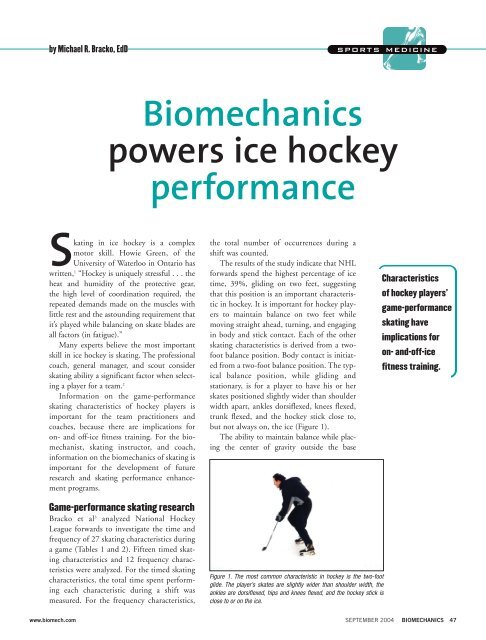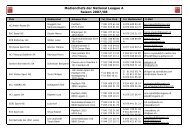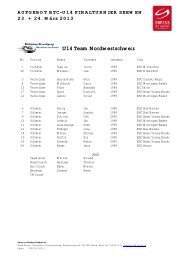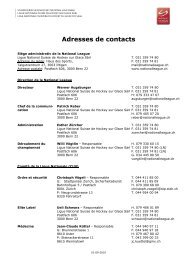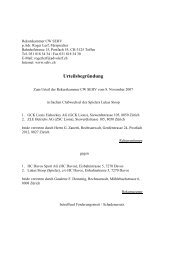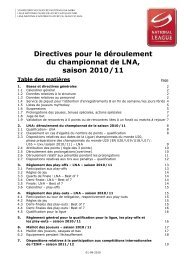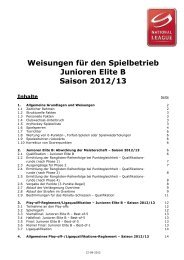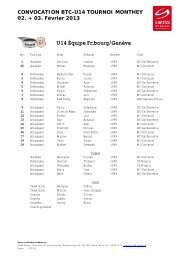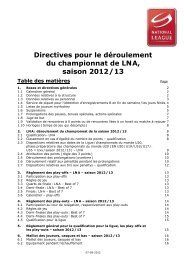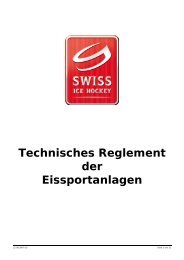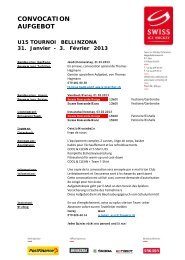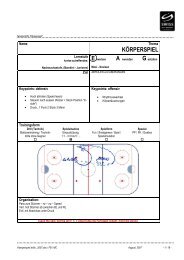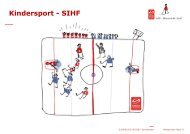Game-performance skating research - Swiss Ice Hockey
Game-performance skating research - Swiss Ice Hockey
Game-performance skating research - Swiss Ice Hockey
You also want an ePaper? Increase the reach of your titles
YUMPU automatically turns print PDFs into web optimized ePapers that Google loves.
y Michael R. Bracko, EdD<br />
sports medicine<br />
Biomechanics<br />
powers ice hockey<br />
<strong>performance</strong><br />
Skating in ice hockey is a complex<br />
motor skill. Howie Green, of the<br />
University of Waterloo in Ontario has<br />
written, 1 “<strong>Hockey</strong> is uniquely stressful . . . the<br />
heat and humidity of the protective gear,<br />
the high level of coordination required, the<br />
repeated demands made on the muscles with<br />
little rest and the astounding requirement that<br />
it’s played while balancing on skate blades are<br />
all factors (in fatigue).”<br />
Many experts believe the most important<br />
skill in ice hockey is <strong>skating</strong>. The professional<br />
coach, general manager, and scout consider<br />
<strong>skating</strong> ability a significant factor when selecting<br />
a player for a team. 2<br />
Information on the game-<strong>performance</strong><br />
<strong>skating</strong> characteristics of hockey players is<br />
important for the team practitioners and<br />
coaches, because there are implications for<br />
on- and off-ice fitness training. For the biomechanist,<br />
<strong>skating</strong> instructor, and coach,<br />
information on the biomechanics of <strong>skating</strong> is<br />
important for the development of future<br />
<strong>research</strong> and <strong>skating</strong> <strong>performance</strong> enhancement<br />
programs.<br />
the total number of occurrences during a<br />
shift was counted.<br />
The results of the study indicate that NHL<br />
forwards spend the highest percentage of ice<br />
time, 39%, gliding on two feet, suggesting<br />
that this position is an important characteristic<br />
in hockey. It is important for hockey players<br />
to maintain balance on two feet while<br />
moving straight ahead, turning, and engaging<br />
in body and stick contact. Each of the other<br />
<strong>skating</strong> characteristics is derived from a twofoot<br />
balance position. Body contact is initiated<br />
from a two-foot balance position. The typical<br />
balance position, while gliding and<br />
stationary, is for a player to have his or her<br />
skates positioned slightly wider than shoulder<br />
width apart, ankles dorsiflexed, knees flexed,<br />
trunk flexed, and the hockey stick close to,<br />
but not always on, the ice (Figure 1).<br />
The ability to maintain balance while placing<br />
the center of gravity outside the base<br />
Characteristics<br />
of hockey players’<br />
game-<strong>performance</strong><br />
<strong>skating</strong> have<br />
implications for<br />
on- and-off-ice<br />
fitness training.<br />
<strong>Game</strong>-<strong>performance</strong> <strong>skating</strong> <strong>research</strong><br />
Bracko et al 3 analyzed National <strong>Hockey</strong><br />
League forwards to investigate the time and<br />
frequency of 27 <strong>skating</strong> characteristics during<br />
a game (Tables 1 and 2). Fifteen timed <strong>skating</strong><br />
characteristics and 12 frequency characteristics<br />
were analyzed. For the timed <strong>skating</strong><br />
characteristics, the total time spent performing<br />
each characteristic during a shift was<br />
measured. For the frequency characteristics,<br />
Figure 1. The most common characteristic in hockey is the two-foot<br />
glide. The player’s skates are slightly wider than shoulder width, the<br />
ankles are dorsiflexed, hips and knees flexed, and the hockey stick is<br />
close to or on the ice.<br />
www.biomech.com SEPTEMBER 2004 BIOMECHANICS 47
TABLE 1. TIMED SKATING<br />
CHARACTERISTICS OF NHL FORWARDS<br />
SKATING CHARACTERISTIC<br />
% OF TOTAL TIME ON ICE<br />
Two-foot glide 39<br />
Cruise slide 16.2<br />
Medium intensity <strong>skating</strong> 10<br />
Struggle for puck or position 9.8<br />
Low-intensity <strong>skating</strong> 7.8<br />
Backward <strong>skating</strong> 4.9<br />
High-intensity <strong>skating</strong> 4.6<br />
Two-foot stationary 3<br />
Two-foot glide with puck 1.4<br />
Medium-intensity <strong>skating</strong> with puck 0.8<br />
Cruise stride with puck 0.6<br />
Struggle with puck 0.6<br />
Low-intensity <strong>skating</strong> with puck 0.5<br />
High-intensity <strong>skating</strong> with puck 0.4<br />
Two-foot stationary with puck 0.4<br />
of support appears to be important for game-<strong>performance</strong> <strong>skating</strong>.<br />
Bracko et al 3 also analyzed the most commonly occurring<br />
<strong>skating</strong> characteristics during the first 30 seconds after a puck has<br />
been dropped in a face-off (Table 3). In this specific game situation,<br />
the two-foot gliding position was rarely sustained. Rather,<br />
it was interspersed with striding characteristics such as cruise<br />
strides, struggle for puck or position, medium-intensity <strong>skating</strong>,<br />
and low-intensity <strong>skating</strong>.<br />
Even though high-intensity <strong>skating</strong> was utilized for a low percentage<br />
of total on-ice time, it is also considered an important<br />
characteristic as it relates to the nature of ice hockey. Using quick<br />
bursts of speed (followed by gliding) to maintain position or possession<br />
of the puck, to maintain speed, or to initiate body contact,<br />
is how hockey players gain advantage over opposing players.<br />
Biomechanical <strong>research</strong> on forward striding<br />
Marino and Weese 4 identified three phases in the <strong>skating</strong> stride:<br />
the single-support propulsion phase, the double-support propulsion<br />
phase, and the single-support glide/recovery phase. Their<br />
analysis indicates that propulsion starts while one skate is on the<br />
ice and the other skate is approximately halfway through the<br />
recovery phase. The recovery phase is the period of time immediately<br />
after the skate pushes off before it is brought forward to be<br />
put back on the ice to push off again. The propulsion phase continues<br />
as the recovery skate is put on the ice (double-support<br />
propulsion phase). When the propulsion skate is brought back<br />
onto the ice, it should be in line with the knee, hip, and shoulder<br />
(Figure 2). The single-support glide phase is the brief period of<br />
time during which one skate is gliding and the skater decelerates.<br />
Marino 5 studied the kinematics of <strong>skating</strong> at different velocities.<br />
He found that stride rate increased with velocity, but that<br />
there was no change in stride length. Therefore, velocity depends<br />
more on the number of strides than the length of the stride.<br />
Page 6 used 14 youth, college, recreational, and professional<br />
players to determine the differences between fast and slow<br />
skaters. Players were filmed while <strong>skating</strong> as fast as possible over<br />
a distance of 12.19 m. The film was used to measure hip abduction<br />
angle, knee flexion angle, hip-skate forward inclination<br />
angle, trunk angle relative to the ice, and the time it took the<br />
propulsion skate to get back on the ice after push-off. The markings<br />
made by the skates on the ice were used to measure left,<br />
right, and total stride width. Stepwise multiple regression and<br />
multiple stepwise discriminant analyses were used to distinguish<br />
the differences between the fastest skaters in each group and for<br />
the entire group (Table 4).<br />
The authors found that four of the eight characteristics distinguishing<br />
fast skaters from slow skaters were related to stride<br />
width: left stride width, right stride width, width between<br />
TABLE 2. FREQUENCY SKATING<br />
CHARACTERISTICS OF NHL FORWARDS<br />
Figure 2. The double-support portion of the propulsion phase finds the recovery skate<br />
on the ice in line with the flexed knee and hip and the shoulder.<br />
SKATING CHARACTERISTIC<br />
% OF TOTAL OCCURRENCES<br />
Left cross-over turn 20.2<br />
Gliding left-turn 17.8<br />
Right cross-over turn 17.7<br />
Gliding right-turn 16.4<br />
Stop and start 10.4<br />
Forward to backward pivot 7.6<br />
Backward to forward pivot 6.3<br />
Gliding left turn with puck 1<br />
Right cross-over turn with puck 1<br />
Left cross-over turn with puck 1<br />
Gliding right turn with puck 0.4<br />
Stop and start with puck 0.2<br />
48 BIOMECHANICS SEPTEMBER 2004 www.biomech.com
strides, and hip abduction angle. This study also found that the<br />
propulsion skate spent less time in recovery phase after push-off<br />
in faster skaters than in slow skaters. This is corroborated by<br />
Marino and Weese, 4 who found that fast hockey skaters kept<br />
their recovery skate close to the ice to ensure a rapid completion<br />
of the recovery phase and quickly reposition the skate for<br />
further propulsion. Page 6 also found that fast skaters had more<br />
knee flexion immediately prior<br />
to the propulsion phase, and<br />
slow skaters did not flex their<br />
knees as much during fast <strong>skating</strong>.<br />
The faster skaters in the<br />
study also flexed their trunks,<br />
or had more forward lean,<br />
whereas slow skaters were more<br />
upright with less trunk flexion<br />
during fast <strong>skating</strong> (Figure 3).<br />
Shoulder movement<br />
Newton’s Third Law of Motion<br />
dictates that for every action,<br />
there is an equal and opposite<br />
reaction. As this relates to<br />
hockey <strong>skating</strong>, fast skaters<br />
have wide strides because they<br />
push to the side, abducting the<br />
hip during propulsion and<br />
adducting and flexing the hip<br />
during recovery. The equal and opposite reaction to hip abduction<br />
and adduction is shoulder abduction and adduction. The<br />
shoulders have to abduct and adduct with the hips to maintain<br />
balance, momentum, and increased velocity, whether the player<br />
has one or two hands on the stick 7 (Figures 4, 5).<br />
Bracko et al 8 studied the effect of different shoulder movements<br />
on acceleration in high school hockey players. Each subject<br />
was randomly instructed to accelerate with one of two shoulder<br />
movements, either abduction/adduction or flexion/extension. No<br />
significant differences were found between the two acceleration<br />
techniques, but the <strong>research</strong>ers did find differences between<br />
groups that approached statistical significance, indicating that the<br />
athletes who performed shoulder abduction/adduction were faster<br />
than those who performed flexion/extension. It is of interest to<br />
note that 13 subjects were eliminated from data analysis due to an<br />
inability to perform the flexion/extension acceleration technique,<br />
which involved forward and backward shoulder movement. This<br />
may be an indication that the natural movement of the shoulders<br />
during acceleration is abduction and adduction, or “side to side”<br />
shoulder movements.<br />
Figure 3. During fast <strong>skating</strong>, a flexed trunk or forward lean is characteristic of<br />
faster skaters.<br />
Science to practice<br />
Although the biomechanics and game-<strong>performance</strong> movement<br />
patterns of hockey players have been well established by <strong>research</strong>ers,<br />
this information has gone unused by many coaches<br />
and <strong>skating</strong> instructors. 9 Typically, coaches and <strong>skating</strong> instructors<br />
will use figure <strong>skating</strong> and speed <strong>skating</strong> skills, drills, and<br />
techniques to enhance hockey <strong>skating</strong> <strong>performance</strong>. 7,9 However,<br />
figure <strong>skating</strong> and speed <strong>skating</strong> skills and body positions are<br />
rarely, if ever, used during a hockey game and their use in <strong>skating</strong><br />
<strong>performance</strong> enhancement programs should be questioned. 7,9<br />
Marteniuk 10 indicates practicing non-game-like <strong>skating</strong> drills on<br />
the ice during practice can introduce artificial situations that may<br />
inhibit the acquisition of a high<strong>performance</strong><br />
motor program. In<br />
order to develop an effective<br />
motor program, a hockey player<br />
should have on-ice practices that<br />
use the same skills, and under<br />
the same conditions, that he or<br />
she experiences during a game. 9<br />
Many coaches and <strong>skating</strong><br />
instructors will have hockey players<br />
practice flexion and extension<br />
of the shoulders and hips when<br />
striding. 7,9 Their reasoning is that<br />
since a hockey player is moving<br />
forward, his or her movements<br />
should be forward (flexion and<br />
extension of the hip and shoulder).<br />
However, it is clear that flexion<br />
and extension of the shoulders<br />
and hips while striding are counterproductive,<br />
and in fact impossible,<br />
in <strong>skating</strong>. The proper movement of the shoulders and hips<br />
during striding is abduction and adduction. A player who can perform<br />
smooth coordinated abduction and adduction of the hips and<br />
shoulders will be a more efficient skater than a player who cannot<br />
produce these movements. Van Ingen Schenau et al 11 have stated that<br />
because the propulsion skate is gliding forward, it cannot exert a<br />
force straight backward. An essential technical aspect of <strong>skating</strong> is<br />
that the direction of the push-off is perpendicular to the gliding<br />
direction of the skate; in fact, De Boer et al 12 and Bracko and<br />
Moeller 13 have indicated that it is impossible for the propulsion skate<br />
to push straight backward during forward striding. This unique<br />
characteristic of <strong>skating</strong> is caused by the low coefficient of friction of<br />
the ice. That being so, for <strong>performance</strong> enhancement, smooth,<br />
TABLE 4. BIOMECHANICAL DIFFERENCES<br />
BETWEEN FAST AND SLOW SKATERS<br />
SKATING VARIABLE FAST SKATERS SLOW SKATERS<br />
Left stride width 21.21 in 17.76 in<br />
Right stride width 29.21 in 20.46 in<br />
Width between strides 21.21 in 17.76 in<br />
Hip abduction angle 48.33º 35.33º<br />
Total recovery time<br />
after push-off 0.37 sec 0.48 sec<br />
Knee flexion angle 106.11º 123.6º<br />
Hip—skate forward<br />
inclination 57º 65.33º<br />
Trunk angle 38.67º 49.2º<br />
50 BIOMECHANICS SEPTEMBER 2004 www.biomech.com
Figures 4, 5. Because a skate cannot be pushed straight back due to the low friction coefficient of ice, skaters push<br />
to the side, abducting the hip during propulsion (adducting during recovery), to gain speed. Abducting and adducting<br />
the shoulders in concert with the hips helps skaters maintain balance and momentum and gain velocity.<br />
coordinated abduction and adduction movements of the shoulders<br />
and hips are required for high-<strong>performance</strong> hockey <strong>skating</strong>.<br />
Coaches and <strong>skating</strong> instructors will also have players practice<br />
<strong>skating</strong> with an “upright” trunk, similar to the position of a figure<br />
skater. This is counterproductive because it has been established<br />
3,6 that maintaining a flexed trunk, or forward lean, during<br />
two-foot gliding and striding are characteristics of high-<strong>performance</strong><br />
hockey skaters.<br />
Some examples of hockey-specific drills recommended for<br />
enhancing <strong>performance</strong> include:<br />
• Alternating striding and gliding on the command of a whistle<br />
while turning left and right around cones on the ice so that<br />
players skate around the entire surface of the ice as they would in<br />
a game;<br />
• Skating with a deep knee bend while maintaining a wide<br />
stride with quick recovery after push-off from one end of the rink<br />
to the other;<br />
TABLE 3. SKATING CHARACTERISTICS<br />
30 SECONDS FROM PUCK DROP<br />
SKATING CHARACTERISTIC<br />
TIME ON ICE (SECONDS)<br />
Struggle for puck/position 2<br />
Two-foot glide (gliding left turn - right turn) 2<br />
Cruise stride (left cross-over turn) 1<br />
Two-foot glide (gliding left turn) 2.5<br />
Cruise stride (left cross-over turn) 1<br />
Two-foot glide (gliding left turn) 2.5<br />
Cruise strides (right cross-over turn) 1<br />
Two-foot glide (gliding left turn, right turn) 2<br />
Struggle for puck/position 2<br />
Medium-intensity <strong>skating</strong> (left cross-over turn) 2.5<br />
Two-foot glide (gliding right turn) 1.5<br />
Medium-intensity <strong>skating</strong> (right cross-over turn) 1<br />
Two-foot glide (gliding left turn, right turn) 1.5<br />
Cruise strides 1.5<br />
Low-intensity <strong>skating</strong> (left cross-over turn) 3.5<br />
Two-foot glide (gliding left turn) 2.5<br />
Two-foot stationary with puck 0.4<br />
• For young hockey players, <strong>skating</strong><br />
with one hand on the hockey stick to<br />
practice a smooth, coordinated movement<br />
pattern of the shoulders and hips (arms<br />
and legs);<br />
• Practicing forceful shoulder/arm<br />
movement by keeping the skates on the<br />
ice and forcefully abducting and adducting<br />
the shoulders to produce forward<br />
movement while maintaining a deep knee<br />
bend;<br />
• Accelerating with quick strides to<br />
skate down the ice with wide strides,<br />
maneuver through three or four cones<br />
with quick gliding turns, then accelerate<br />
again and practice the same movement again on the other side of<br />
the ice; and<br />
• Practice all the above <strong>skating</strong> drills while handling a puck<br />
with the hockey stick.<br />
Conclusions<br />
<strong>Game</strong>-<strong>performance</strong> <strong>skating</strong> is characterized by two-foot gliding,<br />
striding characteristics (low-, medium-, and high-intensity <strong>skating</strong>),<br />
and struggling for puck or position. Fast skaters have wide<br />
strides, quick recovery after push-off, deep knee flexion prior to<br />
push-off, and significant forward lean. A wide stride (using hip<br />
abduction) with quick recovery is characteristic of a fast skater. The<br />
propulsion skate is moving, making it impossible to push straight<br />
back when striding. Shoulders abduct and adduct in a smooth<br />
movement pattern coordinated with the abduction and adduction<br />
of the hips. Skating instruction should emulate, as much as possible,<br />
the game-<strong>performance</strong> <strong>skating</strong> characteristics that have been<br />
found in the <strong>research</strong> literature.<br />
Michael R. Bracko, EdD, CSCS, FACSM, is a sports physiologist<br />
and director of the Institute for <strong>Hockey</strong> Research in Calgary, AB.<br />
References<br />
1. Green H. Personal communication, Jan. 17, 2003.<br />
2. Hansen H, Reed A. Functions and on-ice competencies of a<br />
high caliber hockey player—a job analysis. In: Terauds J, Gros<br />
HJ, eds. Science in skiing, <strong>skating</strong>, and hockey. Proceedings of the<br />
International Symposium of Biomechanics in Sports. Del Mar,<br />
CA: Academic Publishers, 1979: 107-115.<br />
3. Bracko MR, Fellingham GW, Hall LT, et al. Performance <strong>skating</strong><br />
characteristics of professional ice hockey forwards. Sports<br />
Med Train Rehabil 1998;8(3):251-263.<br />
4. Marino GW, Weese RG. A kinematic analysis of the ice <strong>skating</strong><br />
stride; In: Terauds J, Gros HJ, eds. Science in skiing, <strong>skating</strong>,<br />
and hockey. Proceedings of the International Symposium of<br />
Biomechanics in Sports. Del Mar, CA: Academic Publishers,<br />
1979: 65- 74.<br />
5. Marino GW. Kinematics of ice <strong>skating</strong> at different velocities.<br />
52 BIOMECHANICS SEPTEMBER 2004 www.biomech.com
Res Q 1977;48(1):93-97.<br />
6. Page P. Biomechanics of forward <strong>skating</strong> in ice hockey.<br />
Unpublished master’s thesis, Dalhousie University, 1975.<br />
7. Bracko MR. The myth of power <strong>skating</strong>. Abstract presented at<br />
“Skating into the future: hockey in the new millennium II,” the<br />
University of New Brunswick hockey Conference, March 22 -<br />
24, 2004, Fredericton, NB.<br />
8. Bracko MR, Fellingham GW, Lyons RD. Glenohumeral<br />
kinematics: a comparison of three techniques during an ice<br />
hockey acceleration test (Abstract). Med Sci Sports Exerc<br />
1996;28(Suppl. 5):S55.<br />
9. Bracko MR. High <strong>performance</strong> <strong>skating</strong> for hockey. Pulse,<br />
November 1999; Sport Medicine Council of Alberta.<br />
10. Marteniuk RG. Information processing in motor skills. New<br />
York: Holt, Rinehart and Winston, 1976.<br />
11. Van Ingen Schenau GJ, de Groot G, de Bor RW. The<br />
control of speed in elite female speed skaters. J Biomech<br />
1985;18(2):91-96.<br />
12. De Boer RW, Schermerhorn P, Gademan H, et al. A geometrical<br />
model of speed <strong>skating</strong> the curves. Int J Sport Biomech<br />
1988;2:175-185.<br />
13. Bracko MR, Moeller JL. <strong>Ice</strong> hockey. In: Moeller JL, Rifat<br />
SR, eds. Winter sports medicine handbook. New York: McGraw-<br />
Hill, 2004.<br />
www.biomech.com SEPTEMBER 2004 BIOMECHANICS 53


